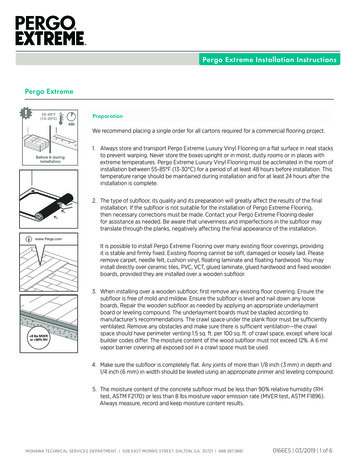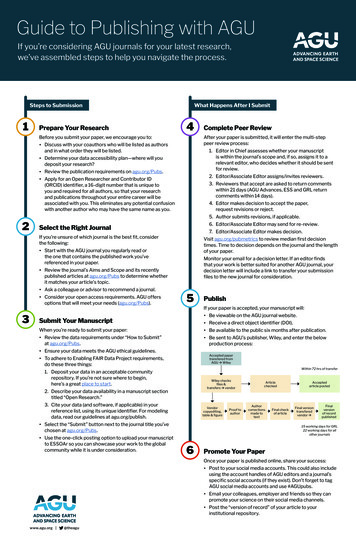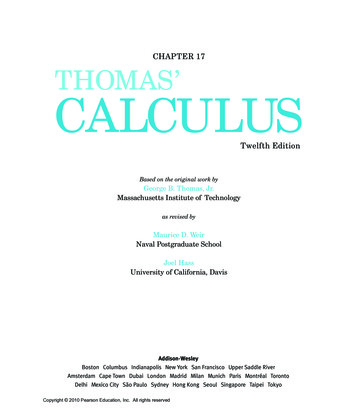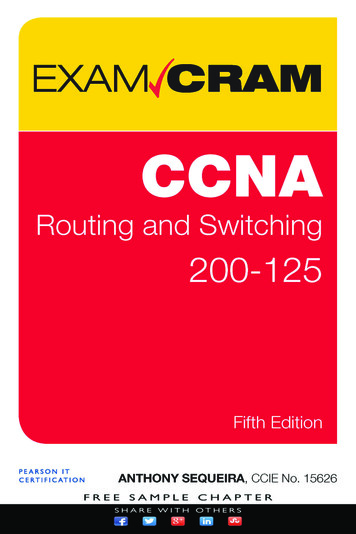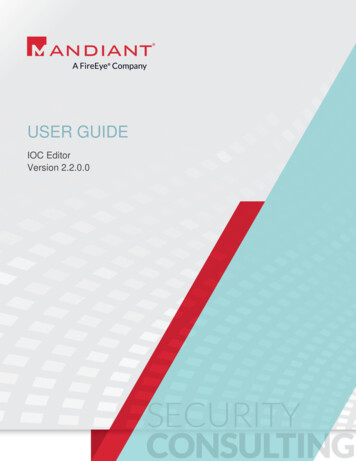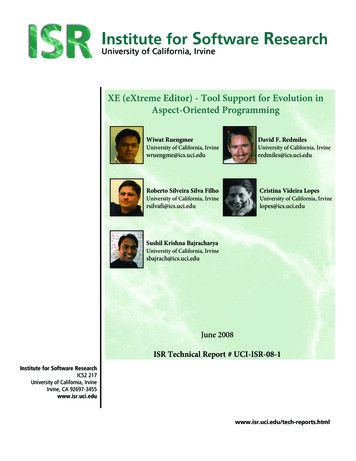
Transcription
Institute for Software ResearchUniversity of California, IrvineXE (eXtreme Editor) - Tool Support for Evolution inAspect-Oriented ProgrammingWiwat RuengmeeDavid F. iversity of California, IrvineUniversity of California, IrvineRoberto Silveira Silva FilhoCristina Videira ty of California, IrvineUniversity of California, IrvineSushil Krishna BajracharyaUniversity of California, Irvinesbajrach@ics.uci.eduJune 2008ISR Technical Report # UCI-ISR-08-1Institute for Software ResearchICS2 217University of California, IrvineIrvine, CA rts.html
XE (eXtreme Editor) - Tool Support for Evolution in Aspect-OrientedProgrammingWiwat Ruengmee, Roberto Silveira Silva Filho,Sushil Krishna Bajracharya, David F. Redmiles, Cristina Videira Lopes{wruengme, rsilvafi, sbajrach, redmiles, lopes}@ics.uci.eduDepartment of InformaticsDonald Bren School of Information and Computer Sciences, University of CaliforniaIrvine, CA, 92697 USAISR Technical Report # UCI-ISR-08-1June 2008Abstract. In spite of the modularization benefits supported by the Aspect-Oriented programming paradigm,different usability issues have hindered its adoption. The decoupling between aspect definitions and basecode, and the compile-time weaving mechanism adopted by different AOP languages, require developers to manage the consistency between base code and aspect code themselves. These mechanisms createopportunities for errors related to aspect weaving invisibility and non-local control characteristics ofAOP languages. In short, AOP developers lack adequate support for: 1) visualizing and identifying theexact points in the code where aspects are woven; 2) preventing aspect-base code inconsistencies, and3) evolving aspect-oriented code in a coherent way. This paper describes XE (Extreme Editor), an IDEthat supports developers in managing these issues in the functional aspect-oriented programming domain. We validate our approach through a case study showing how XE reduces the cognitive effort ofdevelopers in evolving AOP programs.
XE (eXtreme Editor) - Tool Support for Evolution in Aspect-OrientedProgrammingWiwat Ruengmee, Roberto Silveira Silva Filho,Sushil Krishna Bajracharya, David F. Redmiles, Cristina Videira Lopes{wruengme, rsilvafi, sbajrach, redmiles, lopes}@ics.uci.eduDepartment of InformaticsDonald Bren School of Information and Computer Sciences, University of CaliforniaIrvine, CA, 92697 USAISR Technical Report # UCI-ISR-08-1June 2008Abstract. In spite of the modularization benefits supported by the Aspect-Oriented programming paradigm, different usability issues have hindered its adoption. The decoupling between aspect definitions and base code, and thecompile-time weaving mechanism adopted by different AOP languages, require developers to manage the consistency between base code and aspect code themselves. These mechanisms create opportunities for errors related toaspect weaving invisibility and non-local control characteristics of AOP languages. In short, AOP developers lackadequate support for: 1) visualizing and identifying the exact points in the code where aspects are woven; 2) preventing aspect-base code inconsistencies, and 3) evolving aspect-oriented code in a coherent way. This paper describesXE (Extreme Editor), an IDE that supports developers in managing these issues in the functional aspect-orientedprogramming domain. We validate our approach through a case study showing how XE reduces the cognitive effortof developers in evolving AOP programs.Key words: Programming environment, Aspect-Oriented Programming, software development, programunderstanding, program transformations.1 IntroductionAspect-Oriented Programming (AOP) is a methodology that aims to improve the modularity of softwaresystems by encapsulating scattered and tangled code into distinct abstractions called aspects [16]. Aspectabstractions comprise two basic components: the aspect behavior, or advice, and a point cut descriptor (orPCD), which provides references to runtime conditions and the places in the base code where aspect behaviors are woven. Through this mechanism, code weavers combine aspects and base code to form a finalprogram. This programming model promotes the separation of aspect code and base program, allowing theirindependent modification. From a usability perspective, however, the decoupling between aspects and basecode, and the PCD/weaving mechanism raises different problems experienced by many AOP developers[20].The idea of obliviousness to AOP development that would “allow programming by making quantifiedprogrammatic assertions over programs written by programmers oblivious to such assertions” [7] has beenshown to be flawed [21]. This separation actually adds considerable complexity to aspect-oriented development. Popular general purpose AOP languages such as AspectJ [15] employ a regular-expression based PCDlanguage that, while very powerful and general, can lead to problems such as over-weaving (when aspectsare woven to wrong parts of the code) or under-weaving (when aspects are not woven with the code theyshould). For example, in AspectJ, by defining a point cut described as paint*(.) to implement a GUI refresh
UCI-ISR-08-1 June 2008aspect, developers can unintentionally advise base code methods such as paintBrushConfig(). In these situations, neither the weaver nor the compiler can detect these semantic mistakes that can only be perceived atruntime, when the program behaves erroneously.Another common problem faced by AOP developers is the lack of support for evolution. A simple methodrename can break the PCD-base code contract, removing the method from the set of point cuts advised by anaspect. Moreover, semantic changes in the code may also require adjustments to the aspect-base code contract. For example, the addition of a new GUI widget may require a different type of refresh implementation.In order to support this new behavior, the new repaint method needs to adopt a different name conventionfrom the standard paint() command. Another option is to update the PCD to exclude that particular methodfrom its advice. Both options, however, usually require successive trial-and-error compilation cycles to assurethe developer that the change does not impact other methods in the system. It also requires many contextswitches between base code and aspect code to verify the correctness of the PCD descriptors. Both activitieshave shown to increase the cognitive load of the developers, leading to potential programming errors [14].These issues reveal a more fundamental problem in the AOP programming model: the lack of supportfor developers to detect side-effects of semantic changes in the program. Such common mistakes are syntactically correct, and cannot be automatically detected by the aspect weaver nor by the programming languagecompiler. Therefore, they are only detected at runtime, when an erroneous behavior manifests itself, an errorprone and tedious process.In this paper, we present XE, an Integrated Development Environment (IDE) that mitigates these usabilityissues, originated by the lack of feedback to AOP programmers. By supporting automatic edit-time aspectweaving, XE supports developers in assessing the impact of changes they make in either the aspect or thebase code, and helps in the visual detection of both over and under-matching conditions. In doing so, italso avoids the need for repetitive context switches from base to aspect code, which increases the developers’cognitive load. Moreover, in XE both base code and aspect implementations are kept consistent trough theuse of an underlying relational model and engine. This feature supports refactoring and evolution throughthe automatic adjustment of the aspect visualization in response to code changes, and by permitting the enduser to select between different aspect implementations to weave. Finally, through the use of different views,larger-scale projects and debugging are also supported.XE was developed in PLT Scheme, which was selected for its extensibility, and for the ability of the Schemelanguage and environment to support runtime code manipulation. These features significantly simplified ourprototype implementation.The rest of the paper is organized as follows: Section 2 briefly introduces the aspect-oriented programming concepts in Scheme used throughout this paper. Section 3 presents a motivating scenario, showing theproblems of evolving AOP code without appropriate IDE support; Section 4 describes the main features ofthe XE IDE. Section 5 discusses XE implementation details; Section 6 shows how XE can be employed to better support developers in evolving AOP programs. Section 7 presents the results of our evaluation, showingthe cognitive benefits of using XE tool. Section 8 presents related work and Section 9 concludes.2 Aspects in SchemeIn this section, we present the pointcut and advice models we developed for Scheme, showing how theyare used to implement aspects in the functional programming paradigm. Our AOP language mimics theoperators of AspectJ [21].2
UCI-ISR-08-1 June 2008The aspect definition in Scheme consists of a list of advice expressions, each one binding a set of joinpoints to an interceptor expression (typically a function call in Scheme base program) as shown in Figure 1.The advice-type can be any of the types supported in AspectJ, namely before, after and around. A query, jp-query , matches a list of join points of the base program using a regular expression on program identi-fiers. Two pointcut types are supported: call (representing a function call) and exec (representing a functionexecution). Sub-expressions inside a query can be combined using logical operators ‘and’, ‘or’, and ‘not’. Finally, interceptor-exp represents a set of Scheme expressions.( a s p e c t a s p e c t a r g u m e n t s l i s t ( a d v i c e t y p e jp query i n t e r c e p t o r e x p ).( a d v i c e t y p e jp query i n t e r c e p t o r e x p ))Fig. 1. Scheme aspect meta-modelThe current implementation of XE aspect extensions is based on the subset of the Scheme languageimplemented by PLT Scheme, named DrScheme1 . The interpreters used in XE are derived from those implemented in Abelson and Sussman’s book [1]. Hence, XE extends PLT Scheme to support aspects as describedin Figure 1.3 Motivating ScenarioIn this section, we illustrate the use of aspects in XE Scheme, showing a simple example of the problemsfaced by aspect-oriented developers in 1) identifying the exact points in the code where aspects are woven;2) detecting aspect-base code inconsistencies, and 3) evolving aspect-oriented code in a coherent way.3.1 Simple banking transaction APIOur Scheme aspect extension was used to modularize a simple banking transaction API. The original API hadthree major operations: deposit, withdraw, and balance inquire. This API was later evolved to support newfeatures as discussed in this section. We present the steps necessary to modularize and evolve this bankingapplication without any extra XE support. The only available mechanisms are the weaving and execution ofXE Scheme code. Our goal is to mimic the functionality provided by existing AOP weavers and compilers,where no extra IDE support is provided.In the original code, the authentication concern was scattered through the program, individually handledby each function of the API as seen in Figure 2.This code was modularized, within an authentication aspect, by factoring out the permission-checkingcode from the API methods, as shown in Figure 3, and by creating an authentication aspect in XE Schemeas shown in Figure 4. Both base code and aspect code reside in separate files.After separating a concern into base code and aspect code, the developers need to reintegrate (or weave)the aspect and base code behaviors by 1) loading both base code and aspect code files into the XE environment, and 2) manually weaving the aspect code with the base code through a menu command in XE Scheme.Section 4 explains the weaving and unweaving processes in XE Scheme in more detail.1http://www.drscheme.org3
UCI-ISR-08-1 June 2008; ; ( 1 ) Deposit procedure d e f i n i t i o n( define ( deposit )( lambda ( )( i f ( not ( a u t h e n t i c a t e u s e r d b( get username )( get password ) ) )( error ” Authentication Failure ” )false ))( run deposit 2 0 0 0 ) ) ); ; ( 2 ) Withdraw p r o c e d u r e d e f i n i t i o n( d e f i n e ( withdraw )( lambda ( )( i f ( not ( a u t h e n t i c a t e u s e r d b( get username )( get password ) ) )( error ” Authentication Failure ” )false ))( run withdraw 2 0 0 0 ) ) ); ; ( 3 ) Balance procedure d e f i n i t i o n( define ( balance )( lambda ( )( i f ( not ( a u t h e n t i c a t e u s e r d b( get username )( get password ) ) )( error ” Authentication Failure ” )false ))( run show balance ) ) )Fig. 2. Original code with scattered authentication mechanisms( define ( deposit )( lambda ( )( run deposit 2 0 0 0 ) ) )( d e f i n e ( withdraw )( lambda ( )( run withdraw 1 0 0 0 ) ) )( define ( balance )( lambda ( )( run show balance ) ) )Fig. 3. Base code without the factored-out authentication code4
UCI-ISR-08-1 June 2008( define authentication db aspect( aspect ()(( before( call( or( i n s i d e d e p o s i t )( i n s i d e withdraw )( inside balance )))( begin( i f ( not ( a u t h e n t i c a t e u s e r d b( get username )( get password ) ) )( error ” Authentication Failure ” )false ))))))Fig. 4. Database authentication aspect definition3.2 Evolving and debugging the applicationThe original API was very simple; it supported screen-only balance display and the authentication was basedon information stored in a local database (password file). In order to broaden its applicability, the API wasextended to support new functionality: 1) a new print balance function that directs balance inquiry resultsto a network printer, and 2) a distributed (web-based) authentication mechanism that grants access to thenetwork printer. The steps for this course of evolution were:1. The first step towards the evolution of the banking API is to implement the new run-print-balancefunction that sends the balance inquire output to a printer.2. The next step is to extend the balance definition to invoke this function whenever a balance is requested.The balance is then printed both to the screen and to the printer (the result code is shown in Figure 5(1)). After this evolution step, the program becomes semantically incorrect. The (inside balance *)interceptor, which directs the weaving of the database authentication code with the base code, will incorrectly advise (run-print-balance) with the authenticate-db-user code. We call this situation“over-matching”.3. After a weaving/execution/testing cycle, where the wrong behavior becomes evident, a developer correctsthis problem by modifying the wildcard in (inside balance *) to a more specific, (inside balance run-show-balance), as seen in Figure 5 (2). This modification, however, creates another seman-tically inconsistent situation that we call “under-matching”. After this change, the run-print-balanceis no longer advised by any aspect, while it should have been advised by the new authentication-wsaspect aspect.4. After another weave/execute/test when the print jobs could not be completed due to the lack of authentication, the developers detect their mistake. They then create the new aspect, namely authenticationws-aspect, to fix this problem. Let’s suppose that they use a copy-and-paste programming strategy toreuse the old authentication aspect, the authenticate-user-db, as a template for the new authenticateuser-ws. In this process they forget to remove the (inside balance *) and (inside withdraw *) PCD ex-pressions. This common mistake would again result in “over-matching” of other function calls inside5
UCI-ISR-08-1 June 2008; ; ( 1 ) Added new p r o c e d u r e( define ( balance )( lambda ( )( run show balance )( run print balance ) ) ); ; ( 2 ) Modified old aspect( define authentication db aspect( aspect ()(( before( call( or ( i n s i d e d e p o s i t )( i n s i d e withdraw )( i n s i d e b a l a n c e run show balance ) ) )( begin( i f ( not ( a u t h e n t i c a t e u s e r d b( get username )( get password ) ) )( error ” Authentication Failure ” )false )))))); ; ( 3 ) New a s p e c t( define authentication ws aspect( aspect ()(( before( call( i n s i d e balance run print balance ) )( begin( i f ( not ( a u t h e n t i c a t e u s e r w s( get username )( get password ) ) )( error ” Authentication Failure ” )false ))))))Fig. 5. Updated base and aspect codebalance and withdraw. Moreover, a feature interference condition would also occur with the existingauthenticate-ws-aspect.5. At last, after removing the extra PCD expressions, the evolution step is complete and the program iscorrect.In the previous scenario, we showed how a simple evolution step can result in different inconsistent codestages that can result in syntactically correct, but semantically wrong programs. Additionally, it requiredrepetitive switches of context from the base code to the aspect code, followed by repetitive weaving/executioncycles. The root of the problem is the lack of mechanisms to support developers in identifying these situations.In this paper, we argue for the need of instant-feedback mechanisms as supported by XE IDE.6
UCI-ISR-08-1 June 20084 XE IDE FeaturesIn order to address the types of problems described in the last section, we developed XE (Extreme Editor),an IDE that supports developers in the evolution, refactoring, and debugging of aspect-oriented programs(see Figure 6 and Figure 7). As such, XE combines different visualizations, automatic tracking of aspectsand base code, and edit-time aspect code weaving. Combined, these features help developers overcome theusability problems induced by the AOP model. The main features of XE, and their benefits, are described inthis section.Figure 6 and Figure 7 present the main screen of XE. In Figure 6, different aspect and lambda definitionsare shown. In Figure 7, the main editor shows the base code with any woven aspect that the user may haveselected. The Eval console (bottom of the IDE) allows users to run the program whereas the XEval consoleallows users to interact with meta-level functions, for instance functions to generate call graphs or to gatherdifferent joint points in a single view (Section 4.2).Fig. 6. XE main window screenshot illustrates woven code and Eval console4.1 Editing time code weavingXE provides two mechanisms for interacting with the crosscutting structure of the system: 1) the multipleaspects selector (Figure 6), that permits developers to select a sub-set of aspects to automatically weave withthe base code; and 2) edit-time code weaving (Figure 8), that automatically shows the aspect code (highlighted), in-line with the base code (normal font). Through the use of these two mechanisms, a programmercan directly interact with both aspects and base code implementations.For example, if one renames a function argument in a woven view, that change is retained and incorporated into the base code. By the same token, changes to the woven aspect code can either be incorporated intothe original aspect declaration or can be permanently incorporated to the base code itself. Figure 9, showsa user dialog that provides the programmer the option of incorporating the changes to the original aspectcode or to the local function declaration only. Moreover, changes committed to the source aspect definitionare automatically incorporated and updated in all views of program. In the case of incorporation of the aspect code to the base code, the PCD (the aspect’s query definition) is automatically modified to exclude the7
UCI-ISR-08-1 June 2008Fig. 7. XE main window screenshot illustrates gather join point view with woven code and XEval consolecurrent function declaration. This action prevents an aspect behavior to be woven twice in the same functionpoint.By supporting the in-line and consistent modification of both base code and aspect code, XE also allowsdevelopers to avoid switching contexts, between base code and aspect code, in the middle of a task.Fig. 8. Example of edit-time code weaving4.2 Multiple viewsIn addition to the editing-time weaving of code, XE provides two additional views: 1) the gather joint pointview, and 2) the call graph view (see below). Both are particularly important for large-scale projects, when theextension of program code may hinder its complete understanding by single developers. In these situations, itcan be difficult for the developers to visually inspect the code and detect over- or under-matching conditionsusing the edit-mode view alone. These two additional views help to reduce information overload by allowingdevelopers to skip through relevant code snippets or to inspect specific program execution slices. More detailsare presented in the next sections.Gather join point model view A gather join point view allows developers to filter out different identifiedjoin points from the base code, displaying them, together, into a single editable active view. Using this view,8
UCI-ISR-08-1 June 2008Fig. 9. Incorporation of aspect code to base codea developer can interactively test a PCD descriptor expressiveness, detecting any under and over-matchingsituations, or selectively inspect different points in the code. Similar to the normal code view, the editing ofthe woven aspect code or the base code itself are both allowed, any changes being immediately reflected inother parts of the code.A developer produces different gather join point views by specifying queries to XE’s meta-level interpreterusing the XEval pane (see Section 5). For example, by querying (view (call (run-transaction *))),a view is produced that shows any function invocations within run-transaction, as seen in Figure 10 (A).Gather join point view also includes woven code of function calls that are advised by aspects. As shown inFigure 10 (B), run-deposit and run-withdraw are advised by authenticate-aspect.Call graph view The call graph view allows developers to visually inspect individual program executiontraces, looking for inconsistent function calls or aspect weavings. A novel feature of this view is the abilityto show the aspect code in-line with the base code, thus supporting developers in identifying under andover-matching conditions in a program execution trace.This view is produced by specifying a starting point (function) and an ending point (another function)that constitutes a function call chain. For example, (call-graph (inside main run-transaction)(inside run-deposit run-show-balance)) results the list of all intermediate functions calls betweenrun-transaction and run-show-balance, as seen in Figure 11 (A).5 XE ImplementationThis section describes the main XE components and their role in the implementation of IDE.9
UCI-ISR-08-1 June 2008Fig. 10. Gather joint-point viewFig. 11. Call graph viewFig. 12. XE architecture10
UCI-ISR-08-1 June 2008In its core, the XE IDE integrates different components around a common relational model. The typedentities and relations (top of Figure 12), store representations of both aspects and base code. These elementsare selected through the use of a query engine that combines these entities based on Facts and Rules Repository. These rules are automatically produced based on the PCD descriptors of each aspect. Once selected,aspects and base code are combined into the final program that is presented, according to different views,to the developers through PLT rendering engine. Current XE implementation supports the same set of regular Scheme language as in SICP book [1]. XE also uses the same interpreter, EVal, to execute the program.The EVal interpreter is incorporated to XE so that a developer can execute the program and inspect the behavior when aspect is woven or unwoven. In addition, XE provides meta-level interpreter, XEval. XEval isresponsible for integrating aspect and base Scheme codes into a single view so that it is easy for a developerto understand and manage the program. It is central to views such as: gather join point and call graph, aspreviously discussed in Section 4.2. These components and their contribution to the system are described in,more detail, in the following sections.5.1 Relational model and query supportThe internal representation of programs (base code and aspect definitions) in XE is neither text- nor sexpression-based, but relational. Both aspect and base codes are stored as typed entities a relational database.A program is, therefore, a database that can be easily queried. Aspects are ‘stored procedures’ that define active queries. In the functional paradigm, these queries are implemented as meta-level editing functions thatencapsulate the aspect advice and the point cut descriptors. Point cut descriptors are queries in the contentof the program (function names, for example).5.2 XEval engineXEval engine is the component responsible for evaluating the plain text Scheme code. In addition to applying (or executing) the scheme code, XEval engine is also responsible for converting plain code text into aninternal tabular (relational) representation of base code and aspects.5.3 Typed entities and relationsAll the source representations of the program that a programmer interacts with are views rendered in theXE user interface using typed entities and relations information. The views are generated on-demand; as aresult of interaction with XE, or as requested by the developers. For example, clicking on one of the names ina list view of function definitions triggers a rendering of the Scheme representation of the code. To increasequerying performance, query engine maintains the Facts and Rules Repository of the program synchronizedwith the typed entities and relation information so that aspect queries can be quickly resolved.5.4 Rendering engine and code generatorUnder the hood, a Rendering Engine that processes an annotated Scheme representation of the code fromthe Code Generator enables the editing-time visualization of aspects and base code. The Renderer Engine isalso responsible to provide a rich drawing capability on a canvas that also acts as a structured code editor.It supports basic functionality like syntax highlighting and pretty printing. More importantly, it supportscustom decoration of crosscutting fragments of code that are composed as a result of applying aspects on11
UCI-ISR-08-1 June 2008existing lambda definitions. Currently this decoration comes in the form of custom color highlighting ofcode fragments.The code generator produces an intermediate representation of the scheme code to be rendered. Thisintermediate representation is fully annotated with various static-meta information about the many codefragments that constitutes a view. The key role of this meta-information is to support syntax highlighting,code coloring, in-line weaving of code. For example, using this information, the rendering engine gathersand combines code fragments from the: Typed Entities and Relations component and the query results fromQuery Engine.6 Supporting AOP with XEThis section shows how XE supports developers in the evolution and debugging of aspect oriented programsin Scheme. For such, we use the same application discussed in Section 3 and follow the same evolutionarysteps.6.1 Evolving the bank accounting APIThe user starts with a woven view in the main XE editor, where the database aspect authentication (Figure 4)and the base code of Figure 3 appear woven, in the same view, as shown in Figure 13.Fig. 13. Visualizing and identifying the points of woven codeAfter implementing the new run-print-balance function and extending the balance definition to invoke this function; whenever a balance is requested, the authentication aspect is automatically woven to thatfunction call as shown in Figure 14.As the over-matching condition becomes obvious, the developer fixes this problem by changing the inlined aspect code from authenticate-user-db to authenticate-user-ws. After modifying the in-linecode from the source aspect, the developer is given two options as shown in Figure 15, and discussed in thenext sub-sections.Apply the changes to any join point that match this PDC of the aspect Should the developer choose thisoption, the authenticate-db-aspect is automatically revised to exclude any run-print-balance calls from beingadvised by this aspect (see in Figure 16). A new aspect, authenticate-ws-aspect is then created to capture andadvise run-print-balance join points (see Figure 17).12
UCI-ISR-08-1 June 2008Fig. 14. Visually detect the over-matching conditionFig. 15. Dialog providing different change strategiesPermanently incorporating aspect code to this join point If the developer chooses to incorporate theexisting aspect code to the base code, XE automatically revises the aspect PDC to exclude the incorporatedjoin point, thus preventing the re-weaving of the aspect to the new join point. In this case, the revised aspect,produced by the XE IDE would become the one shown in Figure 18.7 EvaluationIn this section, we evaluate the usefulness of XE by quantitatively comparing the efforts required to performour motivation scenario tasks with and without XE support. As such, we compute different metrics as shownin Table 1, collected during the process of evolving the banking API described in this paper. These metricswere chosen to elucidate common problems such as over- and under-matching as well as context switching,which have been shown to increase the developer’s cognitive load [14].These metrics represent:– the number of major steps that the developer
XE (eXtreme Editor) - Tool Support for Evolution in Aspect-Oriented Programming June 2008 ISR Technical Report # UCI-ISR-08-1 Institute for Software Research ICS2 217 University of California, Irvine Irvine, CA 92697-3455 www.isr.uci.edu

